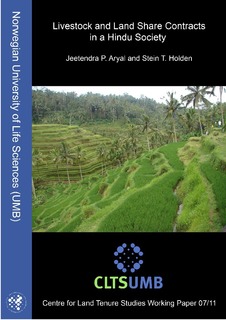Resource information
This paper examines factors related to the existence of a livestock rental market in western Nepal and assesses whether this is associated with caste differentiation and land rental market participation. This study brings new empirical evidence of livestock rental market against the established view that such market does not exist due to moral hazard. Theoretical models for asset- rich (high-caste) households, rich in land and livestock, and asset-poor (low-caste) households are presented providing logical explanations for the existence of a livestock rental market and synergies between livestock and land rental market participation. A combination of double hurdle models and bivariate ordered probit models were applied to test the implications of the models. The empirical evidence was found to be consistent with the theoretical models. Land- and livestock-rich (high-caste) households were more likely to rent out land and/or livestock. Land- and livestock-poor and credit constrained (low-caste) households were more likely to rent in livestock and land. Participation in the two markets was positively correlated indicating synergies that may be due to production and transaction cost reducing benefits. The male labor endowment, partly determined by migration, was a major determinant of livestock rental behavior.

